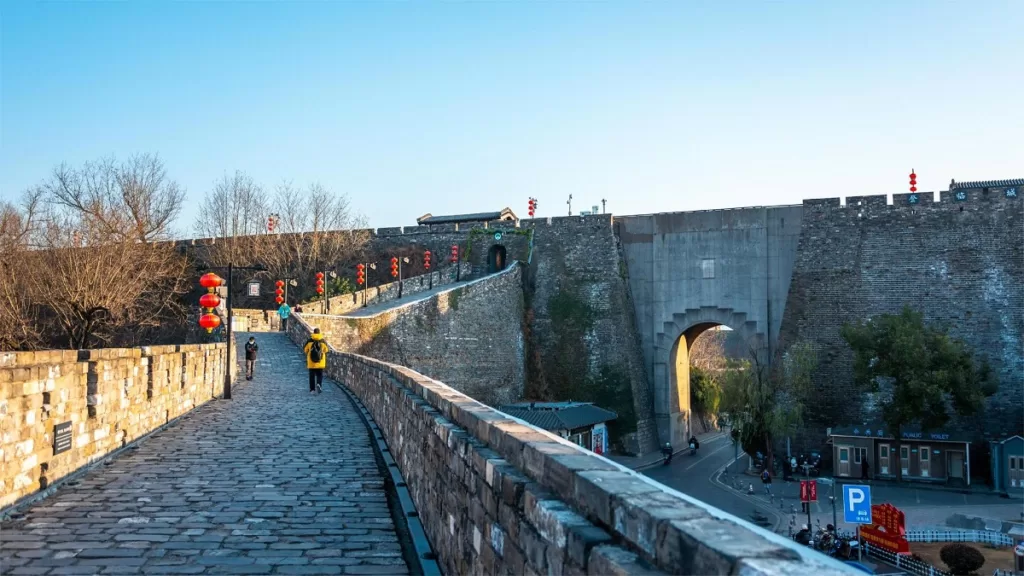Zhongshan Gate – a historical jewel of Nanjing City Wall


The city of Nanjing, steeped in rich history and cultural significance, boasts a remarkable architectural marvel known as the Zhongshan Gate (中山门). Situated in the southern part of the ancient city, the Nanjing City Wall stands tall as a testament to the city’s resilience and enduring heritage. The Zhongshan Gate, one of the most iconic gateways of the city wall, holds a pivotal position in Nanjing’s past and present, serving as both a physical and symbolic connection between history and modernity.
Historical Origins:
Constructed during the Ming Dynasty in the 14th century, the Nanjing City Wall was a massive fortification built to protect the city from external threats and invasions. The wall, measuring approximately 35 kilometers in circumference, featured a series of gates that allowed passage into and out of the city. The Zhongshan Gate, also known as the Middle Mountain Gate, was one of the main entrances, strategically positioned on the southern side.
Architectural Marvel:
The Zhongshan Gate’s architecture epitomizes the mastery of Ming Dynasty builders. Its towering structure stands as a perfect fusion of strength and elegance, reflecting the traditional Chinese architectural style. The gate’s base consists of large stones meticulously arranged to ensure stability and resistance to potential attacks, while its upper levels showcase exquisite craftsmanship with intricate carvings and splendid ornamentation.
Symbol of Power and Authority:
Throughout history, city gates were more than just defensive structures; they also represented the authority and might of the ruling dynasty. The Zhongshan Gate was no exception, displaying imposing features like watchtowers, crenelated walls, and gunports. Guards stationed within the gate were tasked with protecting the city’s inhabitants and regulating the passage of goods and people.
Witness to Historical Events:
The Zhongshan Gate has borne witness to numerous significant historical events. During the Ming Dynasty, it served as a critical site in the defense against the Taiping Rebellion and the Japanese invasions of the 16th century. Moreover, the gate also played a pivotal role during the Qing Dynasty’s conquest of the Ming, marking the end of one era and the beginning of another.
Cultural Significance:
Beyond its historical importance, the Zhongshan Gate holds deep cultural significance for the people of Nanjing and China as a whole. It stands as a living testament to the country’s architectural prowess and serves as a tangible link to China’s imperial past. The gate has been an inspiration for countless artists, poets, and writers, who have immortalized its grandeur in their works.
Restoration and Preservation:
As with many ancient structures, the Zhongshan Gate faced the challenges of time and weathering. Over the centuries, portions of the city wall and its gates suffered damage or neglect. However, the Chinese government recognized the cultural value of the Nanjing City Wall and launched extensive restoration efforts to preserve this invaluable heritage. The Zhongshan Gate was meticulously restored to its former glory, ensuring that future generations can continue to marvel at its beauty and historical significance.
Conclusion:
The Zhongshan Gate of Nanjing City Wall stands proudly as an enduring symbol of Nanjing’s past and present. Its awe-inspiring architecture, historical importance, and cultural significance make it a must-visit destination for history enthusiasts and tourists alike. As a bridge connecting the ancient with the modern, the gate not only preserves the legacy of China’s glorious past but also serves as a beacon of cultural identity and national pride. Today, the Zhongshan Gate remains a living testament to the ingenuity and perseverance of ancient Chinese civilization.